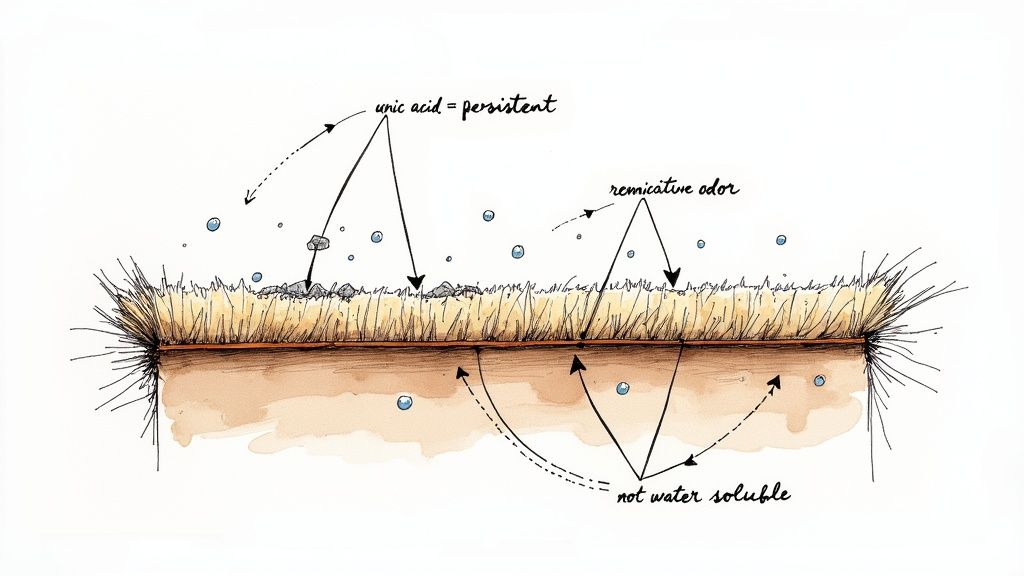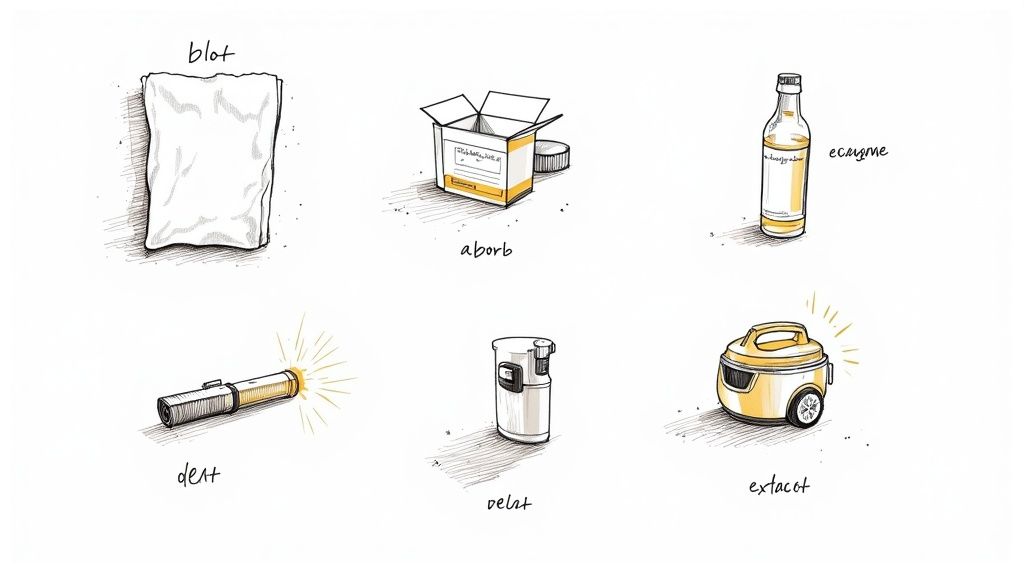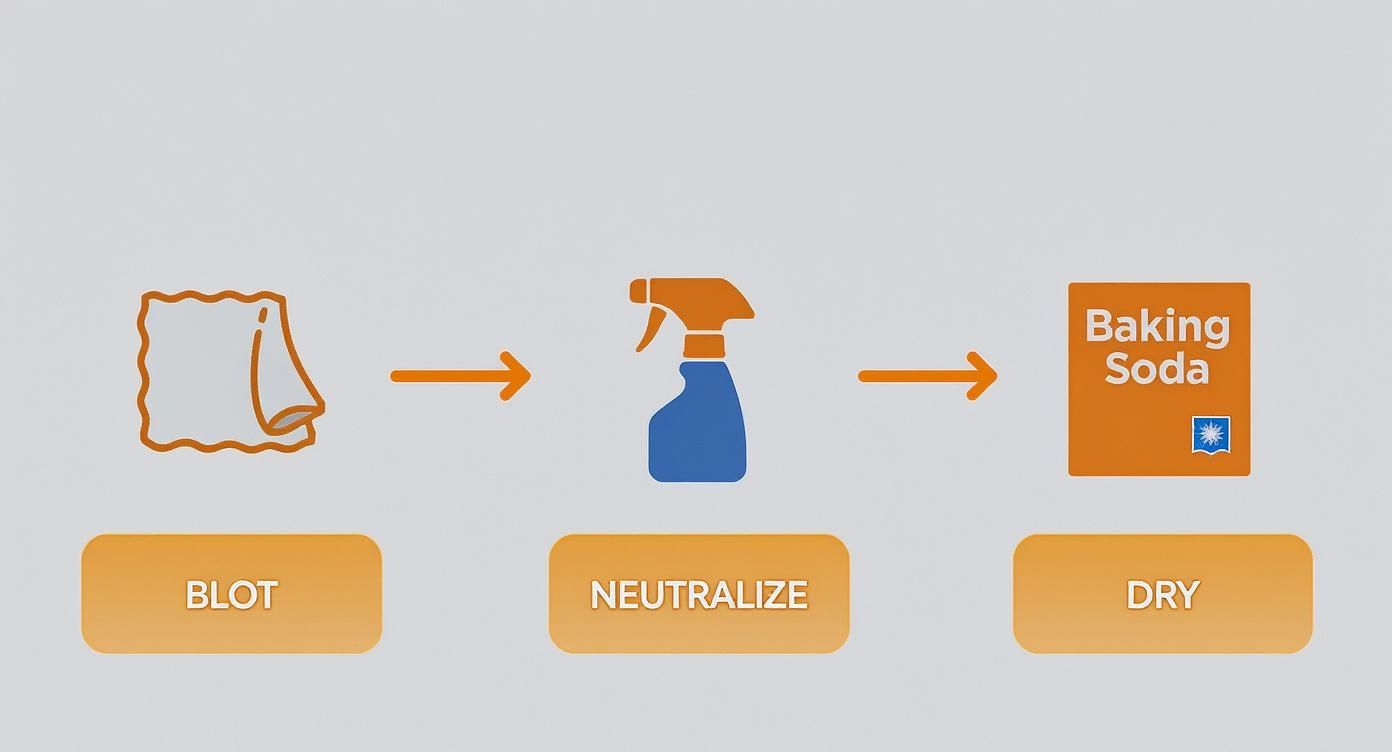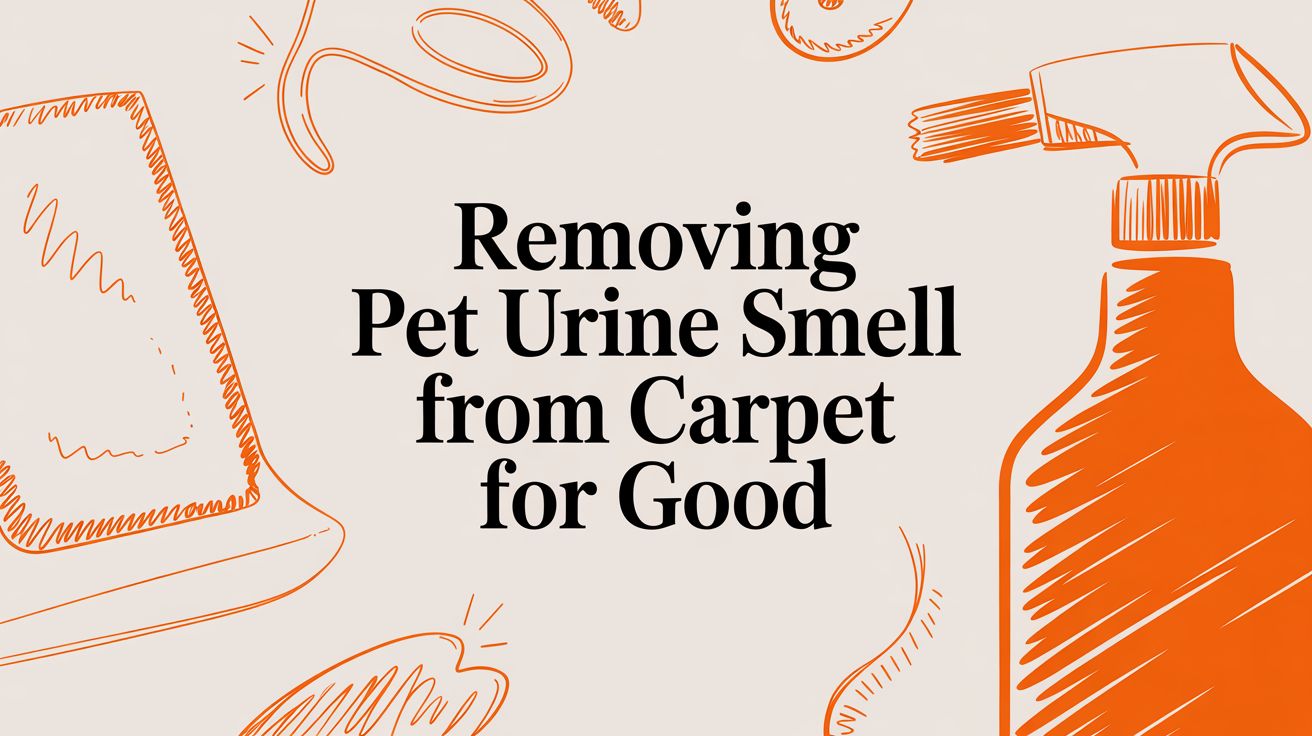To get rid of that awful pet urine smell for good, you have to break down the stubborn uric acid crystals that just don't dissolve in water. This means you need to go way beyond a simple surface scrub. You need natural, enzyme-based solutions that attack the odor at its source, rather than just covering it up with harsh chemicals.
Why That Pet Smell Keeps Coming Back

Ever cleaned up a pet accident, thought you were done, and then caught a whiff of that same foul odor on a humid day? You're not going crazy. There’s a science to why this happens, and it’s all in the unique makeup of pet urine. It’s way more than just a liquid stain; it’s a cocktail of components that make it a real pain to deal with.
When urine dries, you get that initial yellowish stain from urea and urochrome. But the real enemy here is uric acid. Unlike the other stuff, uric acid forms non-soluble crystals that latch onto your carpet fibers for dear life. These little crystals are the true culprits behind that smell that just won't quit.
The Problem with Uric Acid Crystals
Think of uric acid crystals as tiny, invisible odor bombs that simple soap and water can't touch. They hang out deep in your carpet, just waiting for a bit of moisture to reactivate them. That's exactly why the smell seems to pop up out of nowhere when it's damp or right after you thought you cleaned the spot.
This is a huge challenge because the problem goes deep. Technical studies have shown that pet urine doesn't just sit on the surface; it seeps all the way through to the carpet padding and sometimes even the subfloor. In fact, your typical household cleaner barely makes a dent. Research shows they only get rid of about 20% of pet urine odors, leaving the other 80% to linger unless you bring in a specialized enzymatic treatment. For a deeper dive into these carpet challenges, check out what the Carpet and Rug Institute's website has to say.
Key Takeaway: The goal isn’t just to clean the spot you can see. You have to completely destroy the invisible uric acid crystals. If you don't, that smell is guaranteed to come back.
Why Standard Cleaners Often Fail
A lot of common household cleaners can actually make the situation worse. Products loaded with harsh chemicals or ammonia can sometimes set the stain permanently or wreck your carpet fibers. What’s even worse is that ammonia-based cleaners can smell a bit like urine to your pet, encouraging them to mark the exact same spot all over again.
- Soaps and Shampoos: These usually leave behind a sticky residue. This gunk attracts more dirt and just masks the odor for a little while without ever getting to the source.
- Heat and Steam: Whatever you do, don't use a steam cleaner. Applying that kind of heat can actually cook the proteins in the urine and bond them to the carpet fibers, making the smell impossible to remove.
Getting to the root cause of pet odors is everything. If you're looking for broader advice on pet ownership and preventing accidents in the first place, these useful pet care tips are a great start. Ultimately, the only effective strategy for getting pet urine smell out of your carpet is using solutions specifically made to break down organic matter and neutralize those nasty uric acid crystals for good.
Your Go-To Odor Removal Toolkit

When a pet accident happens, every second counts. Fumbling around under the sink for supplies gives that urine more time to dive deep into your carpet fibers and, even worse, the padding underneath. Having a dedicated, well-stocked cleaning kit ready to go can be the difference between a quick cleanup and a lingering odor that just won't quit.
This isn't just about grabbing any old spray bottle. It’s about building a specific arsenal for one purpose: removing pet urine smell from carpet for good. Think of it as your first-response kit for protecting your floors.
The Essential Supplies
Your first line of defense is all about quick absorption and immediate neutralization. Forget the fancy gadgets for now; these are the must-have items you absolutely need.
- High-Absorbency Towels: White or light-colored paper towels or microfiber cloths are key. Why white? Because you need to actually see what you're blotting up. Their high absorbency is critical for pulling as much liquid out as possible before it has a chance to set.
- Baking Soda: This stuff is a true champion. The simple powder is incredible at drawing out leftover moisture and odors from deep within the carpet pile. It works by absorbing the smells, not just covering them up.
- Distilled White Vinegar: The acetic acid in vinegar is a natural enemy of the ammonia in fresh urine, which is what causes that sharp, awful smell. A simple 50/50 mix with water in a spray bottle is a powerful, safe, and effective solution.
It's also smart to know what not to use. Understanding the differences between common disinfectants like hydrogen peroxide and rubbing alcohol can save you from accidentally bleaching or damaging your carpet fibers.
Upgrading Your Toolkit for Tougher Jobs
For those older, stubborn, or mysterious stains, your basic supplies might not cut it. That's when you need to call in the specialized equipment to get to the real source of the problem.
A UV flashlight, sometimes called a blacklight, is a total game-changer. It makes the dried urine salts—which are totally invisible in normal light—glow. This allows you to hunt down and treat every single spot, not just the ones you already knew about. It’s shocking what you might find.
For a truly deep clean, a high-quality enzymatic cleaner is non-negotiable. These formulas aren't just soaps; they contain beneficial bacteria that produce enzymes designed to break down and literally "eat" the uric acid crystals that cause the persistent smell. If you're curious about the science, we break it down in our guide explaining what is an enzymatic cleaner.
The final piece of the puzzle for serious stains is a wet-vac or carpet extractor. This machine flushes the area with your cleaning solution and then uses powerful suction to pull out the dirty liquid, removing contaminants from the padding that simple blotting could never hope to reach.
When you see a fresh pet accident, the clock is ticking. What you do in those first few minutes is the single biggest factor in whether this becomes a minor cleanup or a permanent odor nightmare. The whole game is about stopping that urine from soaking deep into the carpet padding and subfloor, because once it's down there, it's a whole different battle.
The worst thing you can possibly do is grab a brush and start scrubbing like a maniac. I see people do this all the time, and it’s a disaster. All that scrubbing does is push the urine deeper into the fibers and spread the stain out, turning a small puddle into a giant problem.
The Art of Blotting, Not Rubbing
Your number one mission is to suck up as much of that liquid as you can. The only way to do that is by blotting.
Get a thick stack of plain white paper towels or a clean, super-absorbent cloth. Lay it right over the wet spot and apply firm, steady pressure straight down. Think of it like you're trying to squeeze the liquid up from the carpet and into the towel. You'll probably go through a bunch of towels—just keep at it with fresh ones until they come away almost completely dry. This simple move alone can pull out up to 80% of the urine before it even thinks about setting in.
Neutralizing the Ammonia with Vinegar
Okay, with the excess liquid gone, it's time for a little chemistry. Fresh urine is full of ammonia, which is what gives it that sharp, nasty smell. The perfect weapon against it? Plain old distilled white vinegar. It's a mild acid, which is exactly what you need to neutralize the alkaline ammonia.
Mix up a simple but powerful solution: equal parts distilled white vinegar and cool water in a spray bottle. A 50/50 ratio is all you need.
Go ahead and spray the vinegar solution liberally over the whole area. Don't be shy here. You need enough of it to soak down to the same depth the urine did. If the solution doesn't touch all the urine residue, it can't do its job.
Let that mixture sit for about 10 to 15 minutes. This gives the acetic acid in the vinegar time to work its magic and break down the ammonia, knocking out that initial odor source. You'll definitely smell vinegar for a bit, but don't worry—it vanishes completely as it dries. Once it’s had time to sit, grab another clean, dry towel and blot the area again to soak up the vinegar and all the neutralized gunk.
The Baking Soda Finishing Touch
Your final move is to tackle any last bit of moisture and odor. Baking soda is a fantastic natural deodorizer for this. Once the spot is just damp, sprinkle a generous layer of baking soda right over the top.
The baking soda acts like a tiny sponge, wicking the last of the moisture and any smelly particles right out of the carpet fibers. Just let it sit until it's totally dry. This could take a few hours or even overnight. You’ll know it’s ready when the powder is dry and clumpy.
Finish up by vacuuming all the baking soda away. Make sure to go over the spot several times from different directions to get every last bit of powder. This leaves your carpet fresh, dry, and ready for the next steps in our guide to completely removing pet urine smell from your carpet.
Before we move on, let's quickly recap those critical first moves. When an accident happens, you don't have time to second-guess. This table is your cheat sheet for what to do in those first crucial minutes.
Immediate Actions for Fresh Pet Urine Stains
| Action | Method | Why It's Important |
|---|---|---|
| Blot Immediately | Use thick paper towels or a microfiber cloth. Press down firmly; do not rub. | Removes up to 80% of the liquid before it can soak into the carpet pad. |
| Neutralize Ammonia | Spray a 50/50 mix of white vinegar and water. Let it sit for 10-15 minutes. | The acid in vinegar breaks down the alkaline ammonia, neutralizing the initial smell. |
| Absorb & Deodorize | Sprinkle baking soda over the damp area and let it dry completely. | Wicks out remaining moisture and traps lingering odor-causing particles. |
| Vacuum Thoroughly | Once the baking soda is dry and clumpy, vacuum it all up. | Removes the baking soda along with the absorbed moisture and odors for a fresh finish. |
Getting these first steps right makes a world of difference. It sets you up for success and makes the deeper cleaning processes we'll talk about next that much more effective.
How to Eradicate Old and Hidden Urine Odors
A fresh pet accident is one thing, but those old, set-in odors are a whole different animal. When you're dealing with a smell that just won't quit, you've moved past simple cleanup and into a more advanced strategy. The lingering funk from an old stain is caused by uric acid crystals that have literally bonded to your carpet fibers. This chemical bond creates a stubborn odor that loves to reappear with the slightest hint of humidity.
What's really frustrating is that these old stains are often invisible, turning your home into a smelly mystery. To win this battle, you first have to play detective. You can't clean what you can't find, and that's where some specialized tools are an absolute must for removing pet urine smell from carpet for good.
Becoming a Stain Detective with UV Light
Your best friend in this fight is a UV flashlight, often called a blacklight. This is how you uncover those hidden sources of odor.
Wait until it's dark, turn off all the lights, and sweep the blacklight over your carpet. Hold it just a few inches from the fibers. Dried urine has phosphorus and proteins that glow a very distinct yellowish-green under UV light, revealing every single old accident spot.
Brace yourself—you might be shocked at what you find. I've seen it time and again: a small, visible spot on the surface can have a massive, invisible footprint underneath. Using a UV light lets you map out the true extent of the problem so you can treat the entire area, not just the tiny part you can see.
Deploying Enzymatic Cleaners for Deep Decontamination
Once you’ve marked your targets, it’s time to bring in the heavy hitters: a high-quality enzymatic cleaner. These aren't like your standard soaps or detergents. Enzymatic cleaners contain beneficial bacteria that produce enzymes specifically designed to break down and literally eat the organic proteins and uric acid crystals in pet urine.
It's a biological process, not a chemical cover-up. The enzymes are dismantling the odor-causing compounds at a molecular level, completely destroying the source of the smell instead of just masking it.
One study showed that enzymatic cleaners successfully knocked out pet urine odor in 78% of cases when used correctly. Compare that to a measly 22% success rate for traditional cleaners. The research also had a big warning: scrubbing or using hot water can permanently set the odor. You can read more about the science behind effective pet stain removal on PetMD.com.
For this to work, you have to be generous with the cleaner. Really saturate the stained areas. You need enough of the solution to soak as deep as the original urine did, which often means getting down into the carpet padding. Let it sit for several hours, or even overnight, to give those enzymes plenty of time to work their magic.
If you're up against some really stubborn spots, our guide on removing set-in carpet stains has some additional deep-cleaning tricks up its sleeve.
The Citrus-Based Final Rinse
After the enzymes have done their job, a final rinse removes any leftover residue and leaves the carpet fresh. A citrus-based cleaner is my go-to organic choice for this step. The natural solvents in citrus, like d-Limonene, are fantastic at dissolving any sticky stuff left behind from both the urine and the enzymatic cleaner.
This infographic breaks down how to tackle fresh stains to stop them from becoming a bigger problem later on.

As you can see, the basic process of blotting, neutralizing, and drying is the foundation for preventing long-term odor headaches.
To finish the job, lightly spray the citrus solution over the treated area. Then, use a wet-vac or a carpet extractor to pull up all the liquid. This final extraction is critical. It pulls out all the contaminants, leaving your carpet genuinely clean and smelling naturally fresh, not like some heavy perfume.
Common Cleaning Mistakes That Make Odors Worse
When you’re staring down a fresh pet stain, the first instinct is to grab the strongest cleaner you own and just obliterate it. I get it. But believe it or not, some of the most common "fixes" are the very things that can make the problem a hundred times worse.
Rushing in with the wrong stuff can permanently set the stain and the smell. So, before you start scrubbing, let's talk about what not to do. Avoiding these mistakes is just as critical as using the right cleaning method.
Heat Is Your Enemy, Not Your Friend
Lots of people figure heat cleans everything, so they break out the steam cleaner. This is probably the single biggest mistake you can make with pet urine.
That intense heat from the steam literally cooks the proteins in the urine. It causes a chemical reaction that bonds them permanently to your carpet fibers. You’re not removing the stain; you’re fusing it to the carpet for good.
The same goes for hot water. Never use it on a urine spot. Stick with cool or lukewarm water for all your cleaning solutions.
Why Ammonia-Based Cleaners Backfire
Another major misstep is reaching for an ammonia-based cleaner. On the surface, it makes sense—ammonia is a powerful cleaning agent. The problem is, urine already contains ammonia.
When you add more ammonia to the spot, you're not just cleaning; you're actually amplifying the very smell you're trying to get rid of.
Even worse, your pet's powerful sense of smell can easily mistake the cleaner for their own scent. This basically sends them a signal that says, "Hey, this is a good place to pee!" It encourages them to keep marking the same spot over and over, trapping you in a frustrating cycle.
For better options that won't confuse your pet, our guide on safe carpet cleaning for pets has you covered.
The whole point is to break the cycle of remarking, not accidentally encourage it. The wrong product sends the completely opposite message to your furry friend, turning a simple accident into a long-term behavioral problem.
These mistakes don't just affect your carpet; they can hit your wallet, too. Lingering pet odors are a huge red flag in real estate. Homes with noticeable pet smells can see their sale price drop by 5-10%.
While professional treatments have a high success rate—about 85% of cases are resolved—most DIY methods just can't get the job done right. By steering clear of these common errors, you're not just cleaning a spot; you're protecting your carpet and your home's value.
Got Questions About Getting Pet Odors Out?
Even when you follow all the right steps, you're bound to have a few lingering questions. Let's be honest, every pet accident is its own special disaster, and every carpet reacts a little differently.
Getting these little details right is what separates a fresh-smelling carpet from one with a funky odor that keeps coming back. Here are the answers to the questions I hear most often from frustrated pet owners.
Is Hydrogen Peroxide a Good Idea for Pet Urine?
It can be, but you have to play it very, very safe. A mix of 3% hydrogen peroxide and a tiny drop of dish soap can break down the nasty stuff in urine. The problem? Hydrogen peroxide is a bleaching agent. It doesn't care if it's bleaching a urine stain or the color right out of your carpet fibers.
Use it on the wrong type of carpet, and you’ll trade a yellow spot for a permanent bleached-out one.
My Two Cents: Never, ever skip the spot test. Find a hidden area—inside a closet, under the sofa, anywhere it won't be seen—and test your mixture. If you see any color change, stop immediately.
How Do I Know if the Urine Soaked Into the Padding?
Ah, the phantom smell. This is the number one reason DIY cleanups fail. You scrub the surface, it looks clean, but then on a humid day… that awful smell is back. That's a huge red flag telling you the problem has gone deep into the carpet padding. The surface is just the tip of the iceberg.
So, how can you be sure? You have a couple of solid options:
- The Black Light Trick: This is the pro move. Get a decent UV flashlight, turn off all the lights, and shine it on the suspected areas. Old urine salts glow a creepy yellowish-green under UV light. You'll see exactly where the accident happened and, more importantly, how far it spread. You might be shocked.
- The Towel Test: Grab a thick stack of clean paper towels. Place them over the spot and stand on them for about 30 seconds. Really put your weight into it. If the towels come up damp or, worse, smelling like urine, you've got a padding problem.
Will Calling a Professional Carpet Cleaner Actually Fix It?
For tough jobs—old stains, big messes, or smells that just won't quit—bringing in a pro is usually your best bet. We have truck-mounted gear and powerful cleaning agents that can do what a rental machine or a spray bottle simply can't. We can literally flush the contaminants out from deep within the carpet and padding.
But even pros have their limits. If urine has been sitting there for a long time, it can soak straight through the pad and into the wooden subfloor. Once it's in the wood, no amount of surface cleaning will get it out.
In those really extreme cases, the only surefire solution is to pull back the carpet, replace the contaminated padding, and have the subfloor professionally sealed before putting everything back. It's a big job, but sometimes it's the only way to kill the smell for good.
When DIY isn't cutting it, you need someone who gets the science behind odor removal. Citrus Carpet Cleaning Buford uses a low-moisture, citrus-based system that attacks odors at the source without leaving your carpets sticky or soaked. For a home that actually smells clean, schedule your EXACT-imate with us today.

